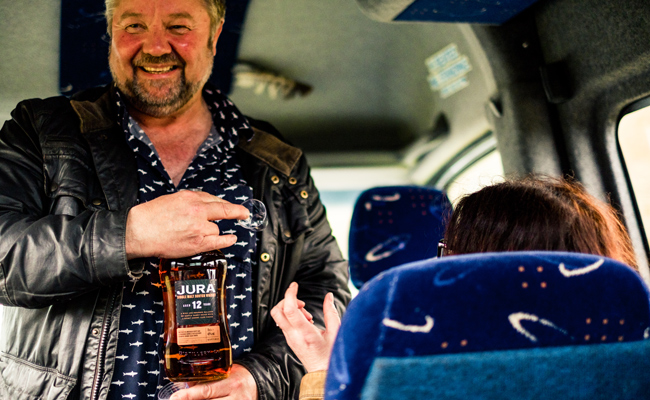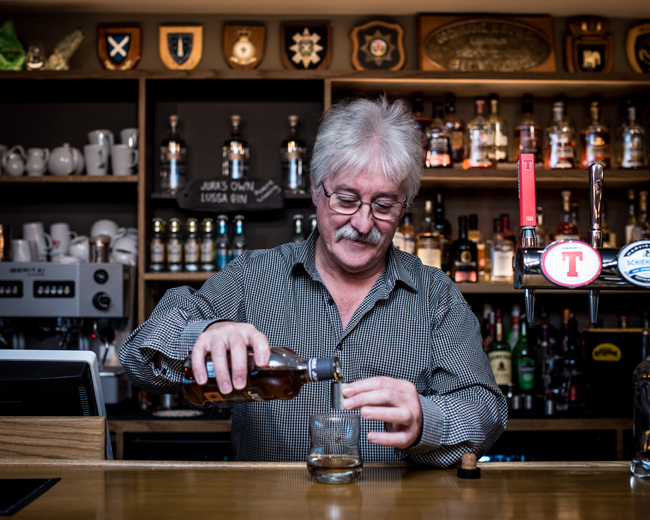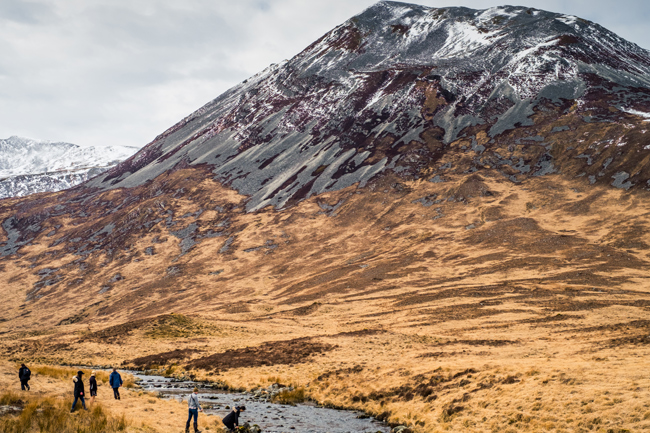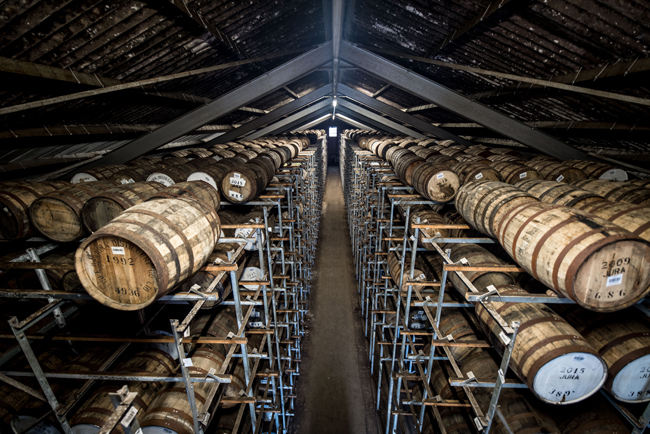
Part of the beauty of scotch, other than that it tastes great and makes you much more confident in your opinions, is that it comes with a free lesson on the people and place that produce it. This aspect of the beverage isn’t necessarily limited to scotch, of course. Learning about any spirit is inevitably a crash course in a few other departments — history, geography, culture, some cursory science, maybe even language (see: rum vs. rhum; whiskey vs. whisky). That’s part of the fun. But while American whiskey certainly has a few regional variations, with Scotch, it goes deeper than that. Flavor is tied to region more closely than with just about any other drink but wine.
So it is that if you’ve read the labels of single malt behind the bar you’ll already be familiar with half the names on a map of Scotland. Ardbeg, Lagavulin, Bowmore, Bruichladdich, Bunnahabhain, Oban. The brands and their origin are often synonymous.
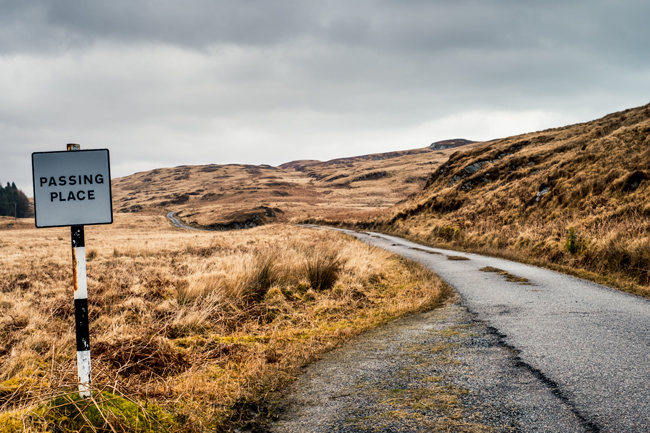
I got the chance to go behind the label recently on the Isle of Jura, and for all I saw and learned and drank, perhaps the most telling moment came when I tried to leave.
Jura sits in Scotland’s Inner Hebrides, an island shaped like two teardrops stacked vertically, about 142 square miles, dominated by three conical quartzite mountains (still glazed with snow when I saw them) called “The Paps,” yet another example of the ever-popular “mountains named after breasts” phenomenon.
Aside from being famous as the place where George Orwell wrote 1984 — that a guy with tuberculosis chose such a permanently damp and chilly isle as the site of his health retreat seems insane, but I also don’t have pre-clean air act London to compare it to — Jura is the birthplace and current home, naturally enough, of Jura Whisky (no ‘E’, that’s how the Scots spell it. Canadians too. One easy mnemonic I’ve heard is that countries without ‘E’ in the name spell whisky without it).
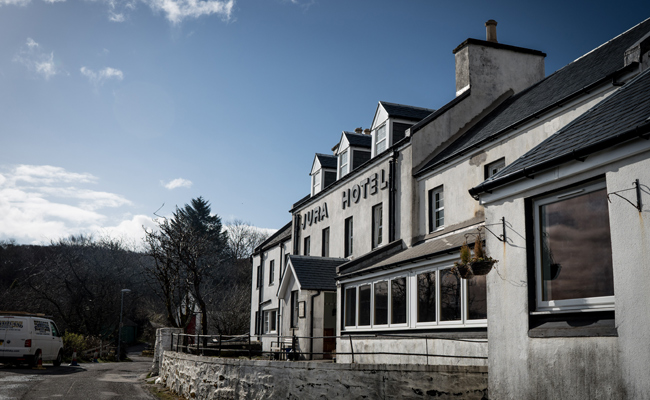
Anyway, about my departure: I was in a car with Jura’s communication manager and two Scottish photographers, all of us invited to cover a Jura (the scotch) “relaunch,” of sorts, including a takeover of Jura’s (the island) tiny (but charming) pub by a few New York mixologists the night before. Jura had a total of 196 residents as of the last census, and getting there from California took one trans-Atlantic flight to London, an intra-UK connection to Glasgow, a puddle jumper from Glasgow to Islay, and a rustic ferry from Islay to Jura. On the day’s third flight I learned from pre-flight announcement that I’d been saying “Islay” wrong my entire life, and that it’s actually pronounced “EYE-luh.”
Jura’s 196 or so residents are connected by just one road, which we were careening down on our way off the island when the car bounced over a pothole. We soon heard the tell-tale flatulations of a blown tire.
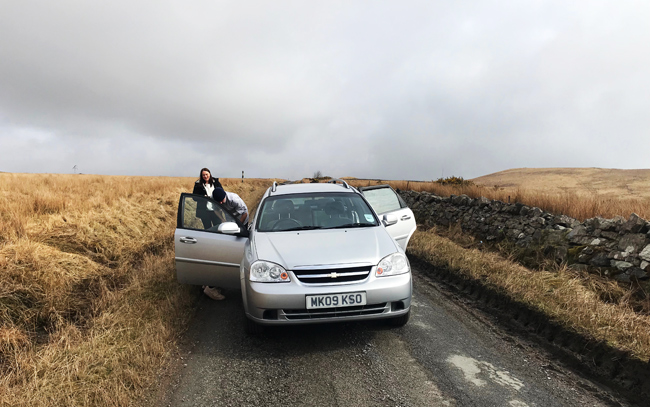
(the flat)
It’s always an adventure when a group of arts majors are forced to change a tire the morning after a pub takeover, but especially so on Jura, which, as previously noted, has only one road. One road that leads to the ferry connecting it to Islay (a comparative metropolis of 3,000 residents). Which is to say, one road, one lane, and one ferry port that, on this particular Sunday, would launch just one ferry. One ferry that we needed to get us to the one flight leaving from Islay to Glasgow that day.
As we struggled with the crappy little jack that we had dug from underneath the floor compartment of the UK-sized Chevy hatchback, another car pulled up behind us. Driving it was a flinty islander named Maggie Boyle (come to think of it, most of the islanders I met were pretty flinty), who was also attempting to catch the noon ferry and was also delayed by the flat, considering the one road to the one ferry to the one plane that day had just one lane, and no shoulder to pull onto, but rather a creek running along one side and an ancient stone wall on the other. (I found a hubcap in the creek, seeming to indicate that ours hadn’t been the only vehicle disabled by this particular pothole.)
Maggie was none too happy with the delay (I didn’t catch her exact words, but they were staccato and grumbly), but we did manage to call ahead to the ferry to tell them to wait, which is apparently something you can do on Jura (provided you have enough cellular reception to make calls — not exactly a given).
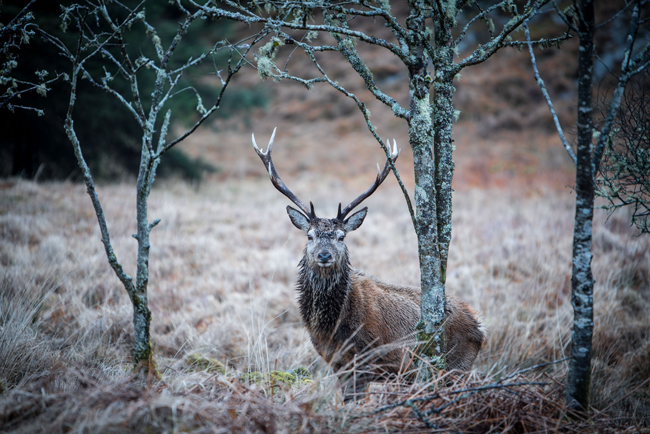
(Jura has more deer than people, and its name is believed to have come from the Old Norse “Dyrøy,” meaning deer island.)
Ah, Scotland. There’s a sort of natural dissonance here, between the ancientness of the landscape, the jagged rocks and rugged scrub and decomposing bogs, the landmarks that sound like something out of a medieval text — one of my favorites being “the Whirlpool of Corryvreckan,” at the north end of the island, which sounds like it should be guarded by John Cleese wearing a helmet made of ram’s horns — and the realities of the here and now. Like needing cell phone reception to catch a ferry. I suspect it’s this dissonance that helps produce the Scottish character, or at least the island character, a particular kind of plainspokenness and good-natured fatalism.
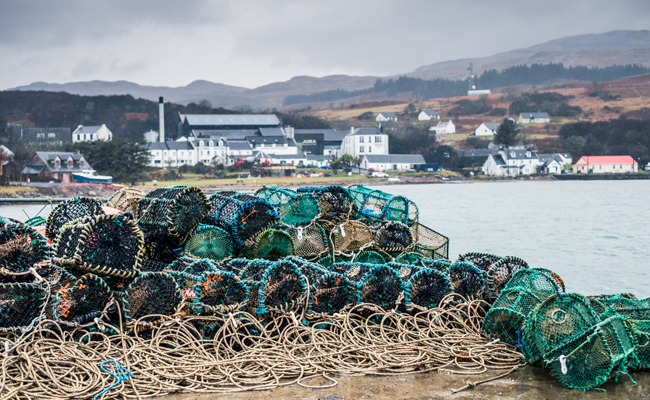
Scotch, as you might imagine, is Jura’s main export. Specifically single malt scotch, and now is a good time to be a single malt producer.
Ah, but what does that mean, exactly?
In order to be called “Scotch,” a spirit must be distilled in Scotland, it must be aged in oak casks for at least three years and one day, and it must have a mash bill of 100% malted barley. “Single malt,” which is a bit of a misnomer, just means the whisky all comes from a single distillery, as opposed to a blended whisky or a blended malt, which is a blend of whiskies from different distilleries. Blended whiskies were more popular in the eighties, and still make up the vast majority of Scotch sales worldwide, but single malts — long the choice of snooty connoisseurs — have jumped 159% between 2004 and 2014, according to the Scotch Whisky Association.
Anecdotally, it’s been obvious for a while that whisky has become “a thing,” much more so for millennials and Gen Y than their parents, and especially on the higher end. LBJ famously drank Cutty Sark (up to two fifths a night, according to some), a light-colored, blended scotch, but if he was alive today it’s hard to imagine that he wouldn’t be drinking a single malt.
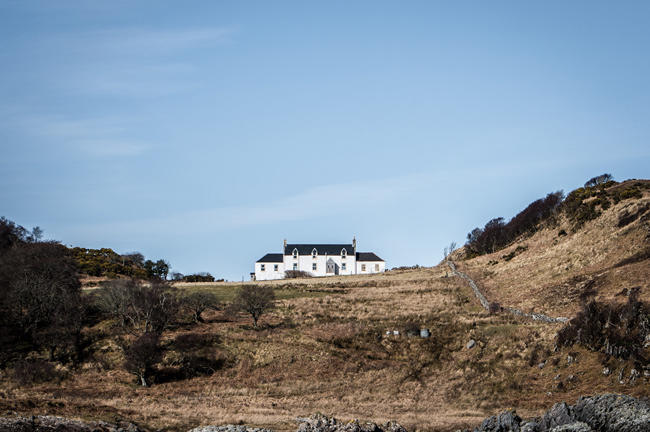
(The insanely isolated house on Jura where George Orwell wrote 1984 — far from the island’s settlements and accessible mainly by boat. He clearly wasn’t here to make friends.)
When most people think of Scotch these days, they think “smoky.” That smoke flavor is largely what separates Scotch from other whiskies, like bourbon and rye. Bourbons can be smoky too, of course, but most of that flavor comes from the char on the barrel, whereas scotch has (or at least, can have) another layer of smoke: the peat. Where much of bourbon’s variation comes from the type of grain used, since single malt is a single grain product, the variation comes largely from the method.
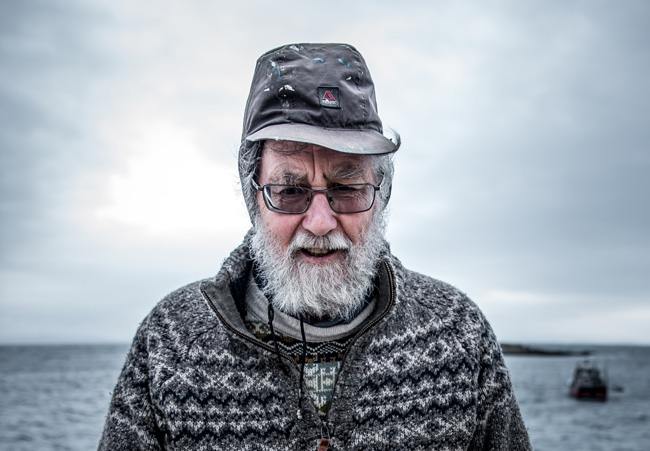
In order to ferment barley, you first have to germinate the grain, soaking it in water to wake up the grains and then redrying them before they get too woke and grow into full-blown barley plants. Those germinated barley grains can be dried using a more indirect heating method, or they can be dried, as is traditional on many Scottish isles, with the help of peat smoke. Peat is a carbon-rich dark, mud-like stuff made from decayed plant matter that was and is burned for heating fuel in Scotland. In old pictures in Jura’s museum, islanders pose next to giant piles of peat, neatly stacked like bricks, often taller than a person. Driving around the island, you can see big square holes where the peat is still being dug up, leaving areas that look like half-peeled scabs.
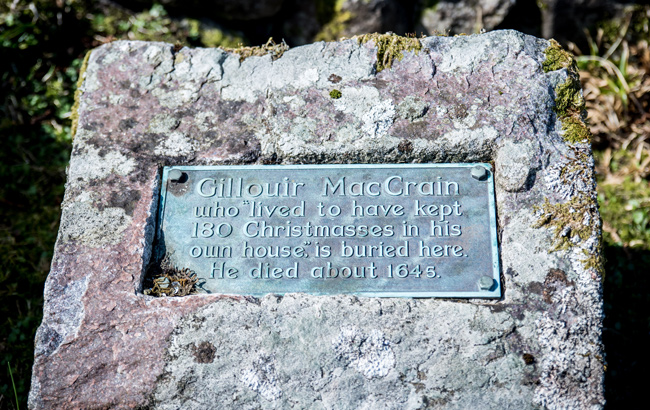
Peat smoking the barley turns out a funky, smoky Scotch — “peaty,” in other words. Traditionally, scotches from the island regions of Scotland, where peat is most common, are the peatiest (like I said, Scotch comes with a geography lesson). Ardbeg, Laphroaig, Lagavulin, Bowmore are all good examples of this. Laphroaig (owned by drinks giant Beam Suntory) still has signage from their bellicose #OpinionsWelcome campaign in their airport displays in Scotland, displaying “user reviews.” Such as, “It tasted like burnt Harley engine oil at first, but the more I drink the better it tastes. Amazing stuff.”; “A big peaty, slap in the face. Perfect.”; and “Because life is too short to drink Scotch that tastes like water,” all displayed in that stylized MAN FONT reminiscent of the past few years of Carl’s Jr ads.
Clearly they’re trying to embrace the “not for everyone” qualities of peaty scotch, much the same way IPA brewers embraced the “not for everyone” qualities of hoppy beers in the early 2000s — partly as a reaction to the “bitter beer face” commercials from earlier in the decade, I’d imagine. As a fan of more balanced drinks (I can’t truly love a peat-bomb Scotch the same way I can’t truly love a hop-bomb beer) I can only hope Laphroaig’s negging doesn’t succeed in the same way. The IPA arms race has been a disaster for those of us who just want a nice medium-hopped amber or a Czech dark lager. (Sierra Nevada actually makes a brew with “distilled hop oil” now. They’ve begun treating hops like cocaine. I digress.)
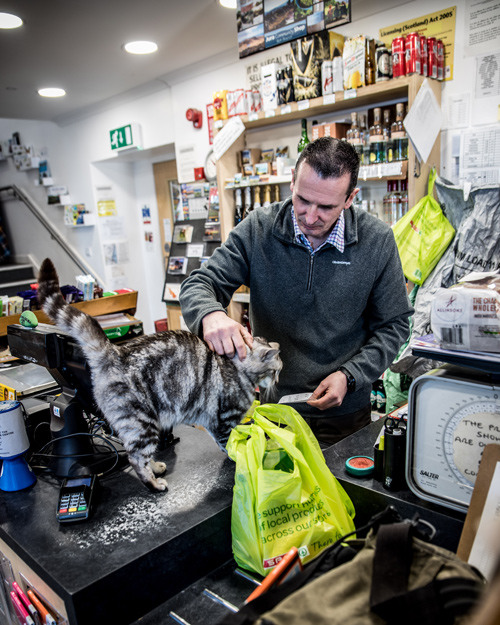
(yes, they have bodega cats in Scotland too)
To go along with the one road, one lane, one ferry, and one pub, Jura has one scotch, called, predictably, Jura. Its distillery, operating since the early 1800s, looks like the Scotland from a storybook. The austere white walls (with “JURA DISTILLERY” in big black lettering) and shiny slate-tile roof face east, towards Jura Sound and the mainland. Facing the distillery from the water, the building’s black and white form a break between the grey of the sky, the brown and green of the grass and scrub, and the dappled grey of the sound. It looks old and tough and permanent, just the way you’d imagine Scotland.
Dotted around the island are stone columns said to date from the Neolithic era, presumably monuments, though so old that no one quite knows. There are Knights Templar gravestones from the 1300s in the graveyard, and others from Viking days. One tomb from the 1600s claims the occupant lived to see “180 Christmases.” Another from the 1800s reads, “…died, aged 128 years.” I don’t know whether I believe either epitaph, but I like the idea that you can drink a lot of scotch and still past 100.
You can smell the distillery long before you get inside the door. Fermenting barley has a very particular aroma, fruity and almost sickly sweet, sort of like baked apples and pears mashed with dark bread. It’s warm, not just because it evokes the scent memory of baked goods and grandma, but because of the actual heat put off by the fermenting bacteria. It’s not an unpleasant smell. Just don’t get carried away and start taking big smells above the fermentation vats like I did. The concentrated alcohol fumes almost knocked me over, and my eyes watered and my nose ran like I’d just taken a hit of wasabi.
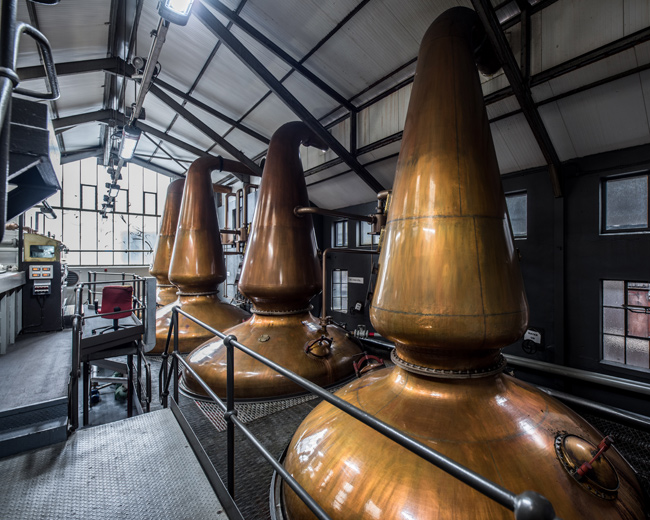
(Jura’s massive pot stills, which are more than three stories tall. Large stills are a hallmark of the highland style, said to produce a “lighter” whisky, the — somewhat psuedoscientific — theory being that the heavier flavor compounds never reach the top of the still)
Geographically speaking, Jura is peculiarly situated, accessible via the ferry from Islay, the traditional home of the Islay-style, those peat-heavy scotches, but is actually closer to the mainland, where the lighter, less smoky highland style predominates. It’s so close to the mainland, in fact, that in the olden days, farmers supposedly swam their cattle across to get to market. I learned this fact on a boat tour of the island, for which I wore both of my coats simultaneously and it still took me the better part of an hour to thaw out to a normal state afterwards. This was in Spring.
It wasn’t the cold so much as it was damp, and the arctic wind that seems to blow right through any cloth barrier. I like to imagine it’s that weather that shapes the Scottish people, squat and wiry and tough, like human live oak trees.
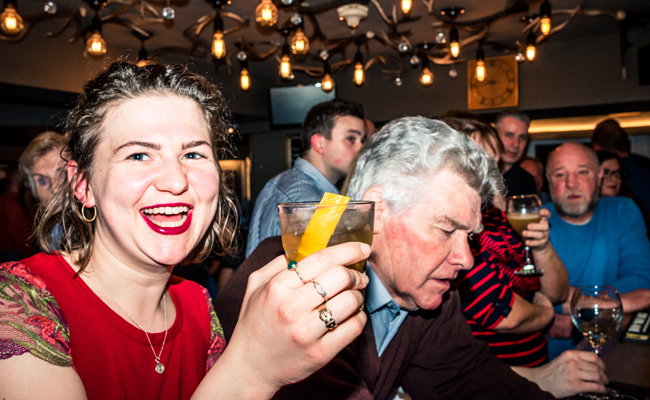
In the past, Jura distillery produced a wider variety of single malts, some with heavy peat, some with none, reflecting their geographical status as sort of a tweener. This turned out to be confusing for the consumer, as once you’ve drunk a peat bomb with “Jura” printed on it, you tend to assume they all are. These days, they work with a peat-smoked malt four weeks out of the year, which gets incorporated into the final bottling equally across all their labels. They all end up tasting a lot like the distillery smells — with notes of apple and pear — and just enough smoke to let you know you’re drinking scotch.
This relaunch, of sorts, was why we were in town. We being a handful of journalists and photographers, and the guests of honor, three bartenders from New York working the pub takeover, set to take place at, typically, Jura’s lone pub. On the night of the event, Gregory Buda from the Dead Rabbit, Shannon Ponche from Leyenda, and Patrick Smith from The Modern, mixed modern, Jura-based cocktails for a crowd of what I can only describe as “agog punters.” (This is the first I’ve ever used the word punter but it feels right).
I suspect this was the most cocktails ever served at the Jura pub, as evidenced by the fact that they ran out of ice halfway through. Island living strikes again.
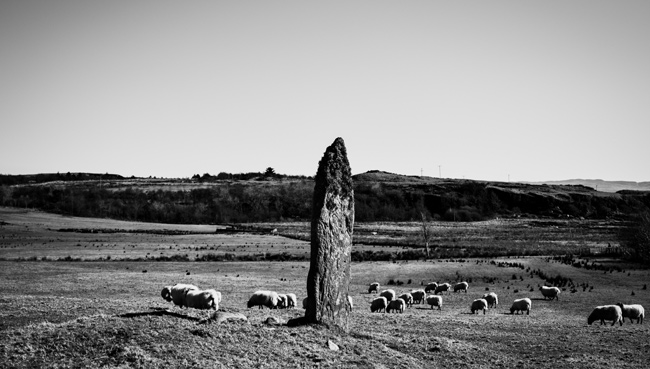
There’s a special magic in spending a Saturday night in a small town’s only gathering place. Like working at a small company where you end up with a variety of responsibilities well outside your original purview, it tends to force you outside the boundaries of your normal personality, of whatever role you’re used to playing wherever you are with whoever you normally hang out. Everyone has their “role,” socially, and that role seems to expand as the location shrinks.
At some point during the night, one of the local bartenders, who seems to moonlight as the guitar player/drunken song leader passed by me and said, “Ah’ve haird you’re quite the singarr.”
Apparently word of the previous night’s karaoke performance (“Army,” by Ben Folds) had spread. I couldn’t tell if I was being gaslit or if I’d just been awarded points for enthusiasm. In either case, I declined a repeat performance that night, though I do maintain that the US lags far behind the rest of the English-speaking world when it comes to drunken singing, and that this is something we should remedy. Nothing pairs with a buzz like a rowdy song.
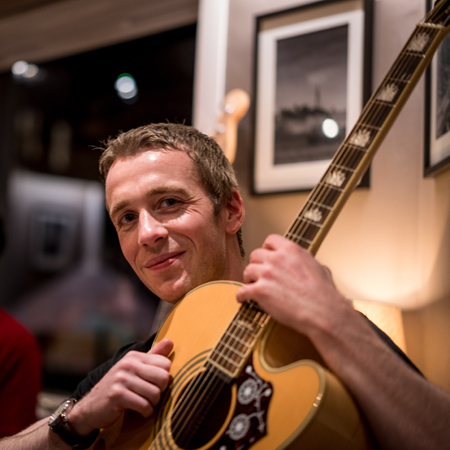
The rest of the night is a little fuzzy, but in the pictures I saw I seemed to be gesturing quite adamantly about something. If you ever wonder what you really think about something, just have some scotch.
Much of my past whiskey writing (read here, here, and here if you’re eager) has explored ways that changing tastes have affected the types of whiskies and cocktails being produced. The tendency of Baby Boomers to reject anything associated with their parents, as opposed to millennials wanting to reclaim old traditions, and how the latter phenomenon has led to an explosion in bourbon and especially rye, for instance.
As I mingled with the locals (and the tourists, mostly from other parts of Scotland, with a handful of Irish and English), that was mostly what I tried to ask about. On an island where the main industry is the distillery, how had the explosion in whiskey popularity in general, and in single malt scotch whisky in particular, affected people’s lives?
I was met mostly with blank stares. Expansion in production aside, it turns out small islands in Scotland don’t change that much. In fact they’re sort of defined by their lack of change. And anyway, any changes wrought by whiskey trends paled in comparison to the island’s bigger news: the Australian hedge fund millionaire Greg Coffey, who bought the 14,000 acre Ardfin Estate on the island (which is itself 90,000 acres) in 2010, was nearly finished building his championship golf course. Coffey had hired Greg Norman’s colleague Bob Harrison to design the course, and had spent a reported 55 million pounds on it (about $74.4 million, as of today’s exchange rate). The course is said to be spectacular, though it’s still an open question whether the public will actually get to play it, or if it will just be Coffey’s personal Pebble Beach.
The locals mostly just seemed happy someone was investing in the island. Someone asked Alex, the driver of our island tour van, who had lived on Jura since 1979 and can recite a poem about the light house from memory (he pronounces the word poem as “poe-yem”), what he thought of Coffey. Alex mentioned having had a drink with him at the local pub a few times and that he’d seemed alright. Though he added, “Ah’m sure ya doan get to whair he is without bein’ a bit of a bastard.”
Have I mentioned how much I like the Scots?
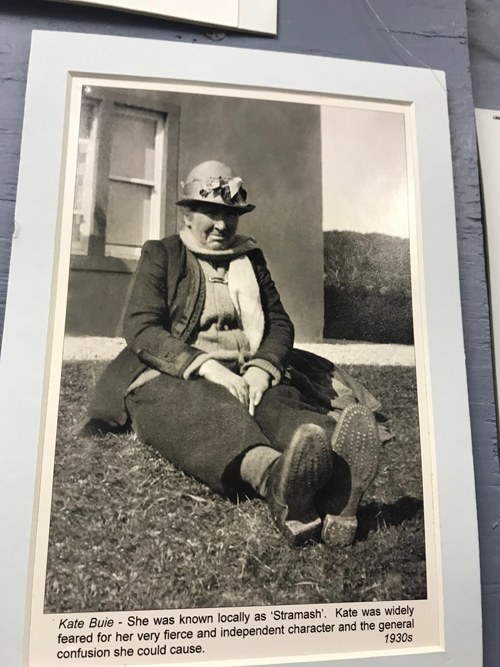
(“Kate was widely feared for her very fierce and independent character and the general confusion she could cause.” Possibly my favorite photo caption ever.)
In any case, it’s good to have “an angle” on a writing trip, but it’s even better when that angle blows up. Because if your assumptions were right all along, why did you need to come in the first place?
It seemed to me that the point was, on Jura, change is relative. Whisky may boom, billionaires may decide they like the view, brands may tweak their messaging, but people have been living on Jura since they were banging rocks together and they’ve been making Scotch for almost as long. If I had come here to see the effects of recent trends, well, I was in the wrong place. There isn’t much new about it… but that’s why we like it.
